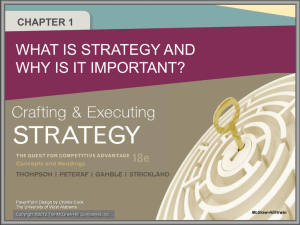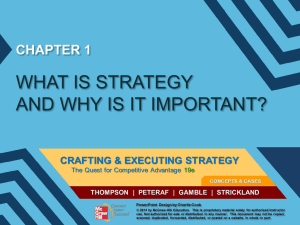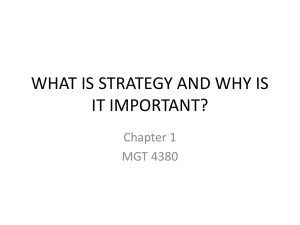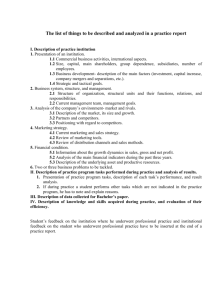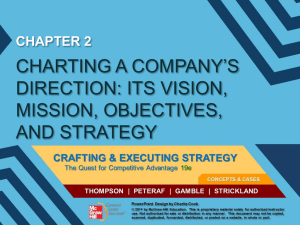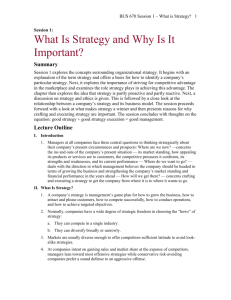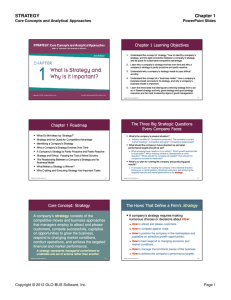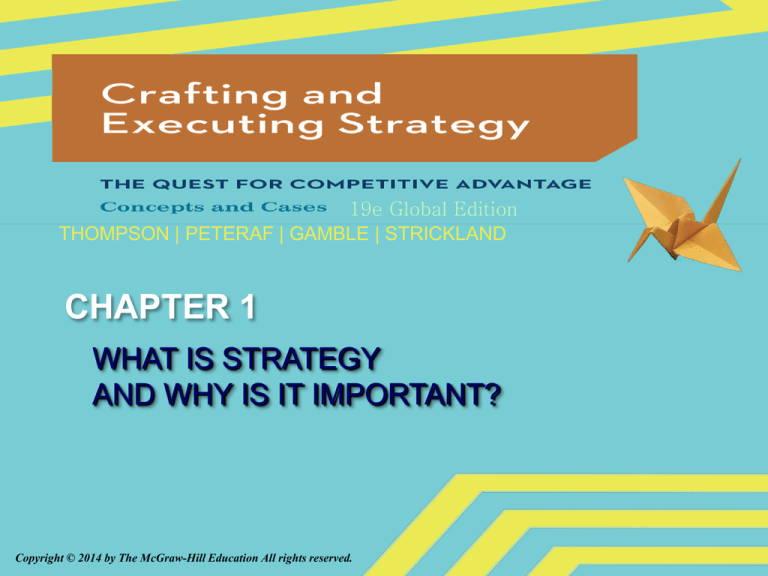
19e Global Edition
THOMPSON | PETERAF | GAMBLE | STRICKLAND
CHAPTER 1
WHAT IS STRATEGY
AND WHY IS IT IMPORTANT?
Copyright © 2014 by The McGraw-Hill Education All rights reserved.
1. Learn what we mean by a company’s strategy.
2. Grasp the concept of a sustainable competitive advantage.
3. Develop an awareness of the five most basic strategic
approaches for winning a sustainable competitive advantage.
4. Understand that a company’s strategy tends to evolve over
time because of changing circumstances and ongoing
management efforts to improve the company’s strategy.
5. Learn why it is important for a company to have a viable
business model that outlines the company’s customer value
proposition and its profit formula.
6. Learn the three tests of a winning strategy.
1–2
CORE CONCEPT
A company’s strategy is its action
plan for outperforming its competitors
and achieving superior profitability
1–3
WHAT DO WE MEAN BY STRATEGY?
What is our present situation?
●
●
Where do we want to go from here?
●
Business environment and industry conditions
Firm’s financial and competitive capabilities
Creating a vision for the firm’s future direction
How are we going to get there?
●
Crafting an action plan for heading the firm in the
intended direction, staking out a market position,
attracting customers, achieving the targeted financial
and market performance, and getting the firm
where it wants to go is its strategy.
1–4
WHAT IS STRATEGY ABOUT?
Strategy is all about How:
●
How to attract and please customers.
●
How to compete against rivals.
●
How to position the firm in the marketplace.
●
How best to respond to changing economic
and market conditions.
●
How to capitalize on attractive opportunities
to grow the business.
●
How to achieve the firm’s performance targets.
1–5
STRATEGIC MANAGEMENT PRINCIPLE
♦ Strategy is about competing differently from
rivals—doing what competitors don’t do or,
even better, doing what they can’t do!
1–6
WHY BOTHER WITH STRATEGY?
A firm needs a strategy to specify what
actions are going to be taken:
●
●
●
To improve its financial performance.
To strengthen its competitive position.
To gain a sustainable competitive advantage
over its market rivals.
A creative, distinctive strategy:
●
●
Helps produce above-average profits.
Increases competitive pressures on rivals.
1–7
STRATEGY AND COMPETITORS
Strategy is about competing differently
from rivals—
●
Doing what they don’t do or doing it better!
●
Doing what they can’t do!
●
Doing things in ways that attract customers
and set a firm apart from its rivals.
●
Doing things in a manner calculated to
produce a competitive edge over rivals.
1–8
FIGURE 1.1
Identifying a Company’s Strategy–What to Look For
1–9
ILLUSTRATION CAPSULE 1.1
McDonald’s Strategy in
the Quick-Service Restaurant Industry
Key initiatives of the Plan-to-Win strategy:
• Improved restaurant operations
• Affordable pricing
• Wide menu variety and beverage choices
• Convenience and expansion of dining opportunities
• Ongoing restaurant reinvestment and international
expansion
1–10
ILLUSTRATION CAPSULE 1.1
McDonald’s Strategy in
the Quick-Service Restaurant Industry
• Which of McDonald’s Plan-to-Win strategy
initiatives are associated with meeting customer
needs more effectively?
• Which initiatives are focused on more efficiently
delivering products and services?
• Which initiatives will likely result in the most
sustainable competitive advantage?
• Which of the initiatives will competitors likely
attempt to overcome first?
1–11
STRATEGY AND THE QUEST FOR
COMPETITIVE ADVANTAGE
Competitive Advantage
●
Require meeting customer needs either more
effectively (with products or services that customers
value more highly) or more efficiently (by providing
products or services at lower cost).
Sustainable Competitive Advantage
●
Requires giving buyers lasting reasons to prefer a
firm’s products or services over those of its
competitors.
1–12
STRATEGIC APPROACH CHOICES
Building Competitive Advantage
Low-cost
provider
Differentiation
on features
Focus on
market niche
Best-cost
provider
1–13
STRATEGIC APPROACHES
Building a competitive advantage by:
●
Striving to become the industry’s low-cost provider
(efficiency).
●
Outcompeting rivals on differentiating features
(effectiveness).
●
Offering the lowest (best) prices for differentiated
goods (best-cost provider).
●
Focusing on better serving a niche market’s needs
(efficiency and\or effectiveness).
1–14
CORE CONCEPT
♦ A firm achieves a competitive advantage
when it provides buyers with superior value
compared to rival sellers or offers the same
value at a lower cost to the firm.
♦ The firm achieves a sustainable competitive
advantage if its advantage persists despite the
best efforts of competitors to match or surpass
its advantage.
1–15
GAINING SUSTAINABLE
COMPETITIVE ADVANTAGE
How to create a sustainable competitive
advantage:
●
Develop valuable expertise and competitive
capabilities over the long-term that rivals cannot
readily copy, match or best.
●
Put the constant quest for sustainable competitive
advantage at center stage in crafting your strategy.
1–16
WHY A COMPANY’S STRATEGY
EVOLVES OVER TIME
Managers modify strategy in response to:
●
Changing market conditions
●
Advancing technology
●
Fresh moves of competitors
●
Shifting buyer needs
●
Emerging market opportunities
●
New ideas for improving the strategy
1–17
STRATEGIC MANAGEMENT PRINCIPLE
♦ Changing circumstances and ongoing
management efforts to improve the strategy
cause a company’s strategy to evolve over
time—a condition that makes the task of
crafting strategy a work in progress, not a
one-time event.
♦ A company’s strategy is shaped partly by
management analysis and choice and partly
by the necessity of adapting and learning by
doing.
1–18
THE EVOLVING NATURE
OF A FIRM’S STRATEGY
Realized (current) strategy is a blend of:
●
Proactive (deliberate) strategy elements that
include both continued and new initiatives.
●
Reactive (emergent) strategy elements that are
required due to unanticipated competitive
developments and fresh market conditions.
1–19
CORE CONCEPT
♦ A company’s deliberate strategy consists of
proactive strategy elements that are both
planned and realized as planned; its emergent
strategy consists of reactive strategy elements
that emerge as changing conditions warrant.
1–20
FIGURE 1.2
A Company’s Strategy Is a Blend of Proactive Initiatives
and Reactive Adjustments
1–21
THINKING STRATEGICALLY
♦ Just for Fun:
●
Using the terms shown in Exhibit 1.2, explain why
U.S. football teams get four downs to make a first
down.
●
How does risk affect play selection (strategy) as a
team fails to advance on each of its four downs?
●
What rules of play in other sports affect how the
basic principles of strategy are applied to game
play?
1–22
THE RELATIONSHIP BETWEEN
A FIRM’S STRATEGY AND
ITS BUSINESS MODEL
Realized
Strategy
$$$?
Business
Model
Competitive
Initiatives
Value
Proposition
Business
Approaches
Profit Formula
1–23
A COMPANY’S STRATEGY
AND ITS BUSINESS MODEL
How the business will make money :
●
By providing customers with value.
●
The firm’s customer value proposition
By generating revenues sufficient to cover
costs and produce attractive profits.
The firm’s profit formula
It takes a proven business model—one that
yields appealing profitability—to demonstrate
viability of a firm’s strategy.
1–24
CORE CONCEPT
♦ A company’s business model sets forth the
logic for how its strategy will create value for
customers, while at the same time generate
revenues sufficient to cover costs and realize
a profit.
1–25
BUSINESS MODEL ELEMENTS
The Customer Value Proposition
●
Satisfying buyer wants and needs at a price
customers will consider a good value.
The greater the value provided (V) and the lower
the price (P), the more attractive the value
proposition is to customers.
1–26
BUSINESS MODEL ELEMENTS (CONT’D)
The Profit Formula
●
●
Creating a cost structure that allows for
acceptable profits, given that pricing is tied
to the customer value proposition.
V—the value provided to customers
P—the price charged to customers
C—the firm’s costs
The lower the costs (C) for a given customer
value proposition (V–P), the greater the ability
of the business model to be a moneymaker.
1–27
THINKING STRATEGICALLY
♦ The share price of Facebook stock has
disappointed its investors since its initial public
offering (IPO) in May of 2012.
●
What external factors could be contributing to the
problem with the Facebook share price?
●
How could the problem be explained in terms of
changes in the value, price, and cost factors
associated with Facebook’s business model?
●
What must Facebook do now to create a business
model that is sustainable over the long term?
1–28
IS OUR STRATEGY A WINNER?
The Strategic
Fit Test
The Competitive
Advantage Test
Winning
Strategy
The Performance
Test
1–29
WHAT MAKES A STRATEGY A WINNER?
A winning strategy must pass three tests:
●
The Fit Test
●
The Competitive Advantage Test
●
Does it exhibit dynamic fit with the external and
internal aspects of the firm’s overall situation?
Can it help the firm achieve a significant and
sustainable competitive advantage?
The Performance Test
Can it produce good performance as measured by
the firm’s profitability, financial and competitive
strengths, and market standing?
1–30
ILLUSTRATION CAPSULE 1.2
Sirius XM and Over-the-Air Broadcast Radio:
Two Contrasting Business Models
Who listens to the radio anymore?
• Given the changes in how people listen to music,
are the business models of Sirius XM and over-theair broadcasters viable over the long term?
• Does Sirius XM’s strategy pass the three tests of a
winning strategy? Does the strategy of over-the-air
broadcasters pass the same tests?
• What internal and external factors will create
difficulties for either competitor in changing its
strategy or business model?
1–31
WHY CRAFTING AND EXECUTING
STRATEGY ARE IMPORTANT TASKS
Strategy provides:
●
A prescription for doing business.
● A road map to competitive advantage.
● A game plan for pleasing customers.
● A formula for attaining long-term standout
marketplace performance.
Good Strategy + Good Strategy Execution =
Good Management
1–32
STRATEGIC MANAGEMENT PRINCIPLE
♦ How well a company performs is directly
attributable to the caliber of its strategy and the
proficiency with which the strategy is executed.
1–33
THINKING STRATEGICALLY
♦ Google’s web browser-based Chrome
operating system and its online applications
suite are now challenging Microsoft’s long-term
dominance of those marketplace sectors.
♦ What should be Microsoft’s first response to
this competitive challenge?
♦ How will Microsoft’s response to this
competitor’s actions affect its business model?
♦ Which competitor’s strategy will likely be the
eventual winner in the marketplace? Why?
1–34
THE ROAD AHEAD
Strategy is about asking the right questions:
●
What must managers do, and do well, to make
a firm a winner in the marketplace?
Strategy requires getting the right answers:
●
Good strategic thinking and good management of
the strategy-making, strategy-executing process.
●
First-rate capabilities and skills in crafting and
executing strategy are essential to managing
successfully.
Welcome and best wishes for your success!
1–35

